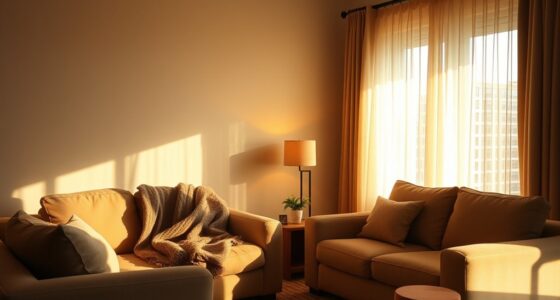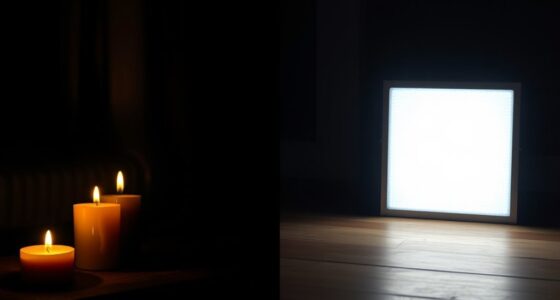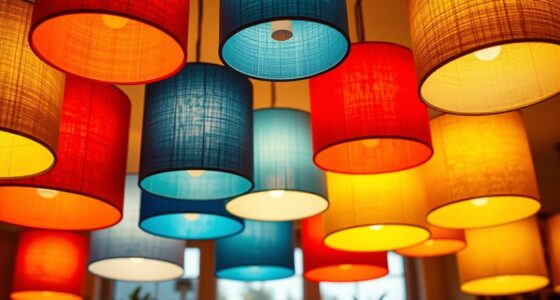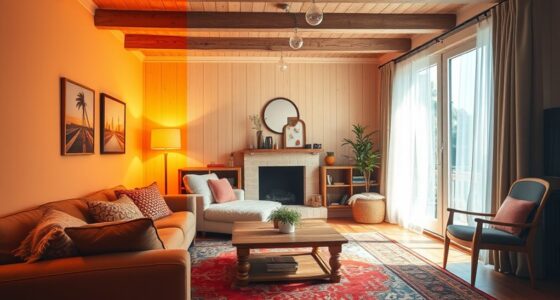Smart lighting systems offer universal device connectivity, meaning you can control your lights through various platforms like voice assistants, mobile apps, or physical switches. They seamlessly integrate with smart hubs, sensors, and other smart home devices, enabling you to automate and customize lighting effortlessly. This setup provides greater convenience, energy savings, and accessibility. If you’re curious about how different devices work together to create a smarter home, you’ll find more insights ahead.
Key Takeaways
- Universal device connectivity allows smart lighting systems to integrate with various brands, platforms, and control methods seamlessly.
- Compatible devices include voice assistants, mobile apps, switches, sensors, and hubs, enabling flexible control options.
- Interoperability ensures that different smart home devices work together, enhancing system scalability and user convenience.
- Integration with high-quality projectors and other smart devices creates immersive and synchronized home environments.
- A universal approach supports evolving user needs, reducing ecosystem limitations and enabling future device additions.
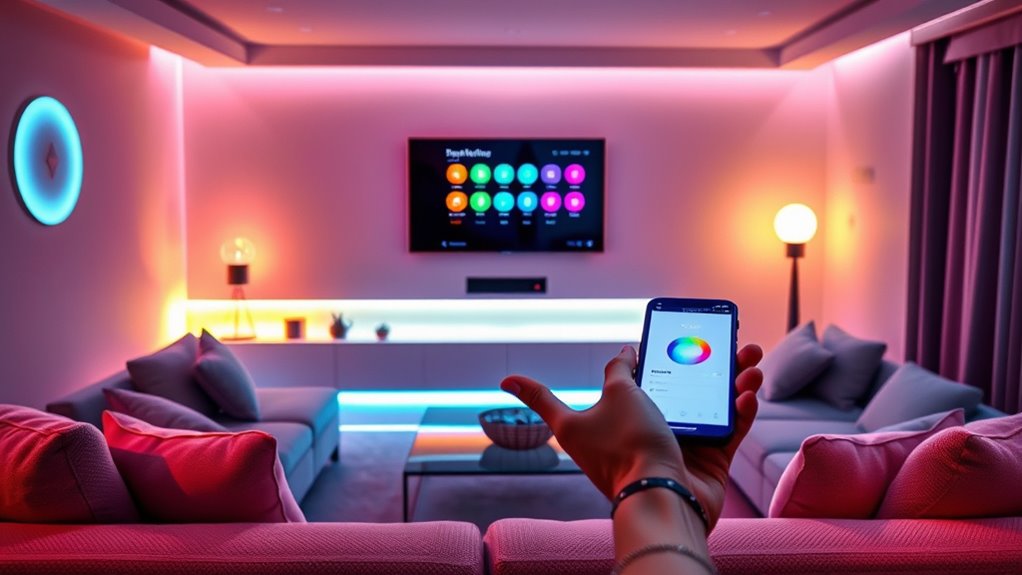
Have you ever wondered how your home lighting can become smarter and more efficient? With the rise of smart lighting systems, you can transform your space into a more convenient and energy-conscious environment. One of the key features that make these systems so appealing is voice control. Instead of fumbling for switches or apps, you simply speak commands, and your lights respond instantly. Imagine telling your smart assistant to turn on the lights as you enter a room or dim them for movie night, all without lifting a finger. Voice control doesn’t just add convenience; it also enhances accessibility for everyone in your household, making it easier for people with mobility challenges to manage lighting effortlessly.
Smart lighting with voice control offers effortless, accessible, and energy-efficient home illumination at your command.
Beyond the ease of control, smart lighting systems are designed with energy efficiency at their core. Traditional bulbs often waste energy when left on unnecessarily or used inefficiently. Smart lights, however, can be programmed to turn off automatically when rooms are empty or to adjust brightness based on time of day or natural light levels. This automation helps you cut down on electricity bills and reduces your carbon footprint. Many smart bulbs also offer dimming features that allow you to set the perfect ambiance without using more power than needed. By integrating these lights into a broader home automation system, you can create schedules and scenes that optimize energy consumption without sacrificing comfort or style.
Universal device connectivity is what truly sets smart lighting apart. It allows you to control your lights through multiple platforms—voice assistants, mobile apps, or even physical switches—giving you maximum flexibility. Whether you prefer speaking your commands through Alexa, Google Assistant, or Siri, or tapping on an app from your phone, your smart lighting system adapts seamlessly. This interoperability means you don’t have to stick with a single brand or technology; instead, your devices work together harmoniously. You can integrate smart switches, dimmers, sensors, and more, all connected through a centralized hub or compatible Wi-Fi networks. This universality simplifies setup and management, ensuring your lighting system remains scalable and adaptable as your needs evolve. Additionally, the integration of high-quality projectors with smart lighting can enhance home entertainment experiences by creating immersive environments tailored to your preferences.
In essence, smart lighting systems with universal device connectivity empower you to create a home that’s more responsive, energy-efficient, and easy to control. Voice commands make operation intuitive, while automation and scheduling features markedly reduce energy waste. The ability to connect various devices and platforms means you’re not locked into a single ecosystem, giving you freedom and flexibility. As technology continues to evolve, these systems will become even more intuitive, saving you money while enhancing your daily life. So, whether you’re upgrading your current setup or starting fresh, embracing these features can make your home smarter, greener, and more user-friendly.
Frequently Asked Questions
How Do Smart Lighting Systems Handle Security and Data Privacy?
Smart lighting systems protect your data by using strong encryption standards, which keep your information secure from unauthorized access. They also require user authentication to make sure only you can control your lights. You should regularly update your system’s firmware and use secure Wi-Fi networks. These steps help maintain your privacy and prevent potential security breaches, giving you peace of mind while enjoying your smart home.
Can Existing Lighting Fixtures Be Upgraded to Smart Systems Easily?
Think of upgrading your fixtures like giving your old lamp a smart glow. Most existing lighting fixtures can be easily upgraded with retrofit options; you just need to add smart bulbs or controllers. Sometimes, wiring modifications are necessary, especially if your current setup doesn’t support smart technology. This process is straightforward and saves you from replacing entire fixtures, turning your familiar space into a modern, connected environment with minimal hassle.
What Are the Power Consumption Differences Between Smart and Traditional Lighting?
You’ll find that smart lighting systems generally use less power than traditional ones, thanks to their energy efficiency features. They automatically turn off or dim when not needed, reducing overall power usage. In contrast, traditional lighting often stays on longer, consuming more energy. So, by switching to smart lighting, you save on energy costs and contribute to a greener environment, making your home more efficient and eco-friendly.
How Do Smart Lighting Systems Integrate With Other Smart Home Devices?
Integrating smart lighting systems with other smart home devices is like fitting puzzle pieces together seamlessly. You can control lights using voice commands, set automation routines, and sync with thermostats or security cameras effortlessly. Through a central hub or compatible apps, your smart lights communicate with other devices, creating a cohesive, intuitive smart home experience. This integration enhances convenience, allowing you to customize your environment with simple commands and automated schedules.
Are There Compatibility Issues Between Different Smart Lighting Brands?
Yes, you might face compatibility challenges between different smart lighting brands. Not all brands prioritize brand interoperability, which can make integration tricky. To avoid issues, check if the brands you’re interested in support common standards like Zigbee, Z-Wave, or Wi-Fi. You can also look for products that are compatible with popular hubs or ecosystems, ensuring smoother operation and easier control across your smart home setup.
Conclusion
Now that you understand how smart lighting systems connect universally, imagine the possibilities that lie ahead. With seamless device integration, your home’s lighting could soon adapt in ways you never expected. But what’s next? As technology evolves, the true potential of these systems remains hidden just beyond your reach. Stay tuned—soon, your lighting might do more than just illuminate; it could revolutionize your entire living experience. Are you ready for what’s coming?

